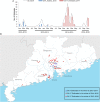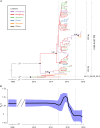The Evolution and Transmission of Epidemic GII.17 Noroviruses
- PMID: 27354370
- PMCID: PMC4957445
- DOI: 10.1093/infdis/jiw208
The Evolution and Transmission of Epidemic GII.17 Noroviruses
Abstract
Background: In recent decades, the GII.4 norovirus genotype has predominated in epidemics worldwide and been associated with an increased rate of evolutionary change. In 2014, a novel GII.17 variant emerged and persisted, causing large outbreaks of gastroenteritis in China and sporadic infections globally. The origin, evolution, and transmission history of this new variant are largely unknown.
Methods: We generated 103 full capsid and 8 whole-genome sequences of GII.17 strains collected between August 2013 and November 2015 in Guangdong, China. Phylogenetic analyses were performed by integrating our data with those for all publically available GII.17 sequences.
Results: The novel emergent lineage GII.17_Kawasaki_2014 most likely originated from Africa around 2001 and evolved at a rate of 5.6 × 10(-3) substitutions/site/year. Within this lineage, a new variant containing several important amino acid changes emerged around August 2013 and caused extensive epidemics in 2014-2015. The phylodynamic and epidemic history of the GII.17_Kawasaki lineage shows similarities with the pattern observed for GII.4 norovirus evolution. Virus movements from Hong Kong to neighboring coastal cities were frequently observed.
Conclusions: Our results provide new insights into GII.17 norovirus evolution and transmission and highlight the potential for a rare norovirus genotype to rapidly replace existing strains and cause local epidemics.
Keywords: epidemic; norovirus; phylogenetic; phylogeographic; virus transmission.
© The Author 2016. Published by Oxford University Press for the Infectious Diseases Society of America. All rights reserved. For permissions, e-mail journals.permissions@oup.com.
Figures




Similar articles
-
Detection and molecular characterization of emergent GII.P17/GII.17 Norovirus in Brazil, 2015.Infect Genet Evol. 2017 Jul;51:28-32. doi: 10.1016/j.meegid.2017.03.011. Epub 2017 Mar 11. Infect Genet Evol. 2017. PMID: 28300648
-
Genetic Analysis of Reemerging GII.P16-GII.2 Noroviruses in 2016-2017 in China.J Infect Dis. 2018 Jun 5;218(1):133-143. doi: 10.1093/infdis/jiy182. J Infect Dis. 2018. PMID: 29617875
-
Prevalence and genotypes of human noroviruses in tropical urban surface waters and clinical samples in Singapore.Appl Environ Microbiol. 2009 Aug;75(15):4984-92. doi: 10.1128/AEM.00489-09. Epub 2009 Jun 12. Appl Environ Microbiol. 2009. PMID: 19525276 Free PMC article.
-
Molecular epidemiology of noroviruses associated with acute sporadic gastroenteritis in children: global distribution of genogroups, genotypes and GII.4 variants.J Clin Virol. 2013 Mar;56(3):185-93. doi: 10.1016/j.jcv.2012.11.011. Epub 2012 Dec 5. J Clin Virol. 2013. PMID: 23218993 Review.
-
[Norovirus epidemic strain GII. 4 evolution--a review].Wei Sheng Wu Xue Bao. 2012 Dec 4;52(12):1431-8. Wei Sheng Wu Xue Bao. 2012. PMID: 23457792 Review. Chinese.
Cited by
-
Norovirus Polymerase Fidelity Contributes to Viral Transmission In Vivo.mSphere. 2016 Oct 19;1(5):e00279-16. doi: 10.1128/mSphere.00279-16. eCollection 2016 Sep-Oct. mSphere. 2016. PMID: 27777985 Free PMC article.
-
Structural Adaptations of Norovirus GII.17/13/21 Lineage through Two Distinct Evolutionary Paths.J Virol. 2018 Dec 10;93(1):e01655-18. doi: 10.1128/JVI.01655-18. Print 2019 Jan 1. J Virol. 2018. PMID: 30333166 Free PMC article.
-
Molecular Evidence of Oysters as Vehicle of Norovirus GII.P17-GII.17.Emerg Infect Dis. 2016 Nov;22(11):2024-2025. doi: 10.3201/eid2211.161171. Emerg Infect Dis. 2016. PMID: 27767928 Free PMC article. No abstract available.
-
Application of the susceptible-infected-recovered deterministic model in a GII.P17 emergent norovirus strain outbreak in Romania in 2015.Infect Drug Resist. 2019 Aug 16;12:2543-2551. doi: 10.2147/IDR.S204175. eCollection 2019. Infect Drug Resist. 2019. PMID: 31496766 Free PMC article.
-
Epidemiology, evolution and transmission of human metapneumovirus in Guangzhou China, 2013-2017.Sci Rep. 2019 Oct 1;9(1):14022. doi: 10.1038/s41598-019-50340-8. Sci Rep. 2019. PMID: 31575919 Free PMC article.
References
-
- van Beek J, Ambert-Balay K, Botteldoorn N et al. . Indications for worldwide increased norovirus activity associated with emergence of a new variant of genotype II.4, late 2012. Euro Surveill 2013; 18:8–9. - PubMed
Publication types
MeSH terms
Substances
Grants and funding
LinkOut - more resources
Full Text Sources
Other Literature Sources
Medical

